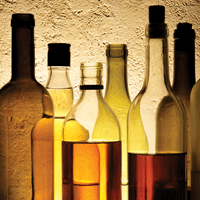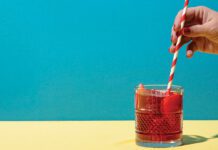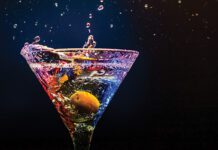What do shoulder pads, Elvis hairstyles and pleated skirts have in common? They’re all retro, and nowadays customers are tipping their hats to alcohol that epitomizes retro glam.
In the beverage world, traditional beers from Europe and old wines such as Malvasia and Malbec are winning popularity. But the rebirth of the classic cocktail is urprising even the most seasoned bartenders.
“I’ve been in the bar business for 12 years but in the last couple of years, I’ve made more Old- Fashioneds and Manhattans than in my whole career,” remarks Lance Seward, bar anager at The Bitter End, a martini bar in Halifax. “We used to go through a bottle of bitters in six months; now it’s three or four a month.”
Justin Taylor, head bartender at Yew in Vancouver and a lead mixologist for the Beverage Committee of the Four Seasons Americas, points out that many of the new bars contributing to the city’s burgeoning cocktail culture “take you back to the speakeasy era; you feel like you should be wearing a fedora.” And, he adds, “At Yew, we’re serving drinks like the Clover Club that was invented in Philly in the 1930s.”
Remember the Tiki? At Calgary’s Raw Bar this year, Colin Tait is crafting retro cocktails with a Polynesian influence. Umbrellas and bamboo cocktail sticks decorate drinks sporting names such as Island Fix ($12, coconut ice cream, Orgeat, lime and rum). “Cocktails sales this year have blown me away,” he admits. “We expected to sell 60 a week; we’re topping 200.”
Despite this apparent renaissance, according to Statistics Canada (Stats Can), the number of Canadian drinking establishments has been steadily declining, from an all-time high of 8,882 in 2004 to 5,724 last year. Nonetheless, liquor stores and agencies sold $5.1 billion worth of spirits during the year-ending March 31, 2011, up 2.9 per cent from the previous year. And, according to NPD, alcohol servings rose four per cent in the last year.
Part of the reason for the discrepancy could be the definition used to identify ‘drinking establishments.’ “The market for bars is shrinking. In response, many have diversified to full menus, so they no longer fit the definition,” Garth Whyte, president and CEO of the Canadian Restaurant and Foodservices Association, points out. “For example, there are Irish pubs that are now serving breakfast.”
The beverage of choice for Canadians is changing, too. According to Stats Can, a decade ago beer had a market share of about 52 per cent in terms of dollar value, compared with about 23 per cent for wine. It was a slightly different story in the year-ending May 2012, when “Foodservice accounted for more than 400-million servings of alcohol in Canada, with beer accounting for 51 per cent, wine for 32 per cent and cocktails for 14 per cent,” says Joel Gregoire of NPD Group.
These days, Canadians are choosing more glamorous drinks. “Sales of premium beverages are rebounding and consumers are trading up again as the economy recovers,” says Julie Rosenberg, senior communications consultant with the LCBO. According to Stats Can, the volume of imported spirits sold in Canada increased from 26 per cent of all spirits sold in 2000 to 34 per cent in 2011, an indicator of higher-end buying.
Red and White
The move to premium wines points to “consumers who are much more educated and engaged and make their buying decisions [based] on knowledge and experience,” says John Szabo, Master Sommelier, wine columnist and beverage director for The Trump International Hotel & Tower Toronto. But while the older, sophisticated consumer has been the traditional wine purchaser, the landscape is changing. “The 25- to 45-year-old bracket is becoming increasingly important,” says the sommelier. “These drinkers have fewer pre-conceived notions about what good wine means, leading to the success of creative brands outside of traditional wine-growing areas and varieties or blends.”
Yew’s Taylor encourages customers to be adventurous with wines from lesser-known regions with the help of some relatively new technology. “The Enomatic lets me pour rare and obscure labels by the glass,” he enthuses, talking about the product that keeps the wine fresh after it’s been opened. “And we can do tasters of two, four or six ounces. On Wine Wednesdays customers can sample several unusual wines. And we support it with a massive tweet-out.”
A huge wine list sounds sexy, but Szabo suggests a slimmed-down list to eliminate “the tyranny of choice.” He notes: “Alcohol levels are coming down; consumers are turning away from monster, over-ripe oaky wines. Moscato (muscat) made in a light, slightly frizzante style (especially from California) is growing by leaps and bounds and appears to be the latest craze.”
Something’s brewing
The move to local continues on the beer front. Craft beers are undoubtedly still the hottest sellers; in Ontario, craft beer continues to be the fastest-growing LCBO beer segment with sales in 2011-12 up almost 45 per cent. In Vancouver, Northwestern microbreweries from either side of the border are making inroads. “In some cases, it’s a case of getting back to our roots,” says Taylor. “Brewery Creek in Vancouver used to have dozens of breweries, and, after so many decades, they’re popping up again. The public loves it.”
Robert Medal, operating partner at Bier Markt, a Toronto establishment with more than 150 beers, both domestic and imported, finds strongly flavoured beers are the biggest sellers. India Pale Ale and particularly hoppy beers are making a strong bid for market share. And he’s seeing demand for stouts flavoured with everything from fruits to coffee, chocolate and crème brûlée.
But sales of classic brews from Europe are also peaking. “People are looking for exotics, beers they’ve tried when travelling. They’re the iconic, more evolved brands,” he says. “There’s demand for German wheat beers and Czech Pilsners.”
Connoisseurs age everything from wine to tea, and beer has joined the list. Medal ages some beer for two years. “It imparts new flavours as it ferments in the bottle,” he says. “The beer becomes more complex.” Sam Adams Utopia — aged up to 16 years in a variety of woods in a Boston warehouse — sells for $25 for two ounces at Bier Markt. “It’s like drinking vintage port or fine cognac,” says Medal.
Mixing it up
“We’re in the third Rennaissance of the cocktail. The first was during Prohibition, the second was in the ’50s and ’60s, and the third is now,” says Frankie Solarik, owner and executive bar chef at Bar Chef, a hot Toronto cocktail bar.
While there are plenty of contemporary drinks on offer, an old ingredient that’s back on the Vancouver scene is the shrub — fruit macerated with sugar and vinegar. Used to flavour drinks in the late 1800s, bartenders today are adding shrubs made of local stone fruits and berries to their cocktails. “Rather than the usual citrus fruit, the vinegar adds acidity to cut the sweetness of a cocktail,” Taylor explains. “And it’s popular, because it keeps the drink local.”
Keeping it local isn’t easy when it comes to bar drinks, but bartenders are making their own bitters, adding local fruits, sweetening with maple syrup or local honey and sourcing alcohol from Canadian distillers. Locally produced spirits are top notch. For example, Prince Edward Distillery Gin garnered 92 points out of 100 (the same score as megabrand Bombay Sapphire) from Chicago’s Beverage Testing Institute, an independent lab that ranks alcoholic beverages.
Indeed, the local movement is strong throughout foodservice and could prove to be a significant differentiation from the competition in the cocktail category. Either way, it’s about mixing modern ideas with retro trends to bump up alcohol sales across the industry.
Keep Reading
Foodservice Operators Up the Ante With New, Gourmet Soup-and-Sandwich Choices
A Close Look At Rapid-Cook Technology
NYC Bans Sale of Large Soda In Foodservice
Brewing Growth: Coffee and Tea Trends for 2012




















